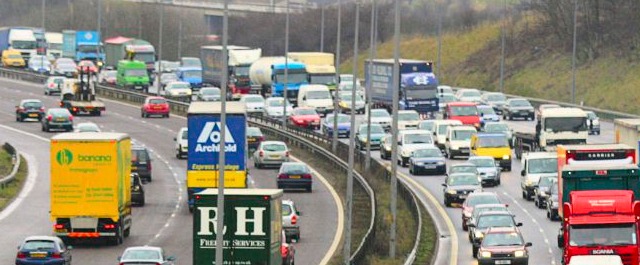UNFIT FOR 80
England’s motorway network is not safe enough to have the speed limit raised to 80mph, according to Unfit for 80, a new report from the Road Safety Foundation.
Poorly-maintained and inadequate roadside protection and the rapidly rising risk of shunt crashes from the sheer volume of traffic using England’s motorways are key factors of safety concern in the report, which is published while the Government continues to consider a review of the motorway speed limit.
Last autumn, Philip Hammond, then Secretary of State for Transport, stated the Government’s desire to “make sure that our motorway speed limit reflects the reality of modern vehicles and driving conditions, not those of 50 years ago … we must consider the huge economic benefits that can be created by shortening journey times”. He promised formal proposals.
The Road Safety Foundation report finds that currently motorways do not provide enough protection to drivers and car occupants to consider raising the speed limit. In new research, it shows widespread faults in run-off protection which are doubling the rate of death and serious injury where there is missing protection. It shows shunt crashes rise exponentially with increased traffic flow, yet only a handful of motorway sections like the M25 and M42 have the electronic controls with hazard warning and variable speed limits that are needed to manage the intense flows common across England’s motorways.
Director of the Road Safety Foundation, Dr Joanne Marden, who oversaw the new research, says: “The vehicle fleet has become safer in the last decade through better crash protection. At motorway speeds, the car alone cannot protect the human body. The car has to work with the motorway’s protection systems such as safety fencing to absorb high speed crash energies. In the next decade, the greatest potential for reducing deaths is on higher-speed roads outside built-up areas. This will be delivered through crash avoidance technology and road engineering catching up to complement improved vehicle crash protection.”
Run-off protection is critical in preventing deaths and serious injuries from single vehicle run-offs: “Our cars provide 4-star or 5-star crash protection but too many of our motorways rate only 3-star with major weakness in run-off protection,” says Dr Marden. “England’s most heavily trafficked motorways can carry a million vehicles within a week. But a one-in-ten million combination of circumstances can arise every three months. Even though they may seem minor, the rate of exposure to any risk is so intense that even minor flaws in motorway layout or safety provision are likely to have serious consequences sooner rather than later.
“These ‘unusual’ circumstances include pedestrians on the hard shoulder, roadworks, extreme weather, spilt loads and rear-end shunts when free-flowing traffic breaks down.”
The report outlines the negative economic effects of a higher speed limit, which include increased vehicle operating costs through higher fuel consumption; increased crashes and crash severity, resulting in raised crash costs; and the increased cost caused by delays from crashes.
The Road Safety Foundation recognises the argument that respect for the 70mph limit is poor and does not dismiss proposals to raise motorway speed limits but concludes: “Drivers who want to are already travelling at 80mph when they can. Economic benefits only arise if ’80 means 90′ and opinion surveys show no public support for that. However, large economic benefits arise from fixing the motorways systematically rather than raising the speed limit. If 80mph is to be trialled, it must be on controlled motorways such as sections of the M25 and M42, because England’s busy motorways cannot cope with 80mph without enforcement and the ability to lower speeds at busy times, bad weather, congestion and other hazards like spilt loads and crashes ahead.”
England’s motorways – the facts:
- They account for 8.5% of all major roads
- Half of England’s motorways carry more than 30 million vehicles a year
- Motorways account for 6% of all England’s road deaths
- Motorways account for 800 serious crashes per year, resulting in 115 deaths and a further 800 serious injuries
- Death and serious injury crashes on cost £0.4bn – or £0.8bn if traffic delays are counted
- Each 10-mile stretch of motorway averages 4 fatal or serious injury crashes per year
- Between 2001 and 2010, motorway deaths fell by 42%, while on roads generally, deaths fell by more than 47%
- Shunt and run-off crashes together account for around half of motorway serious crashes
The rate of death and serious injury on motorways depends on features such as:
- protection between traffic in opposing directions
- junction layout
- quality of roadside protection (eg posts, trees or steep embankments too close to the roadside)
- presence of a hard shoulder for use in an emergency
- bends and sight lines
- the quality of signing and marking
- the skid resistance of the road
- level of traffic flow and presence of a mix of road-user groups
- actual traffic speeds and the speed limit
The Foundation recommends the key measures to deliver economic benefits and improve the safety of motorways should be to:
- bring motorways up to a minimum 4-star standard by 2020;
- install full motorway control systems across the network where flows exceed 85,000 vehicles per day by 2020 and improve the value engineering of these systems;
- install general information and warning systems across the remainder of the network by 2020;
- ensure signing and marking regimes follow best international practice so that they can be read by the vehicle systems which are being introduced over the next five years.
Media contact
Hadstrong: David Armstrong/Becky Hadley 020 7808 7997
Road Safety Foundation: Joanne Marden/Caroline Moore 01256 345598

